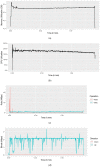The SSTeP-KiZ System-Secure Real-Time Communication Based on Open Web Standards for Multimodal Sensor-Assisted Tele-Psychotherapy
- PMID: 36559967
- PMCID: PMC9787895
- DOI: 10.3390/s22249589
The SSTeP-KiZ System-Secure Real-Time Communication Based on Open Web Standards for Multimodal Sensor-Assisted Tele-Psychotherapy
Abstract
In this manuscript, we describe the soft- and hardware architecture as well as the implementation of a modern Internet of Medical Things (IoMT) system for sensor-assisted telepsychotherapy. It enables telepsychotherapy sessions in which the patient exercises therapy-relevant behaviors in their home environment under the remote supervision of the therapist. Wearable sensor information (electrocardiogram (ECG), movement sensors, and eye tracking) is streamed in real time to the therapist to deliver objective information about specific behavior-triggering situations and the stress level of the patients. We describe the IT infrastructure of the system which uses open standards such as WebRTC and OpenID Connect (OIDC). We also describe the system's security concept, its container-based deployment, and demonstrate performance analyses. The system is used in the ongoing study SSTeP-KiZ (smart sensor technology in telepsychotherapy for children and adolescents with obsessive-compulsive disorder) and shows sufficient technical performance.
Keywords: OCD; WebRTC; healthcare monitoring; internet of medical things; open standards; performance evaluation; security; sensor networks; telepsychotherapy.
Conflict of interest statement
The authors declare no conflict of interest. The funders had no role in the design of the study; in the collection, analyses, or interpretation of data; in the writing of the manuscript; or in the decision to publish the results.
Figures



























References
-
- Lin T., Heckman T.G., Anderson T. The efficacy of synchronous teletherapy versus in-person therapy: A meta-analysis of randomized clinical trials. Clin. Psychol. Sci. Pract. 2022;29:167–178. doi: 10.1037/cps0000056. - DOI
MeSH terms
LinkOut - more resources
Full Text Sources
Medical

